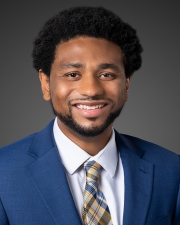Damani White-Lewis studies why university faculties often lack diversity

Why do workplaces, including university faculties, often lack racial diversity? One of the most common explanations is that the pool of minoritized candidates is too small and hard to reach. But to Penn GSE Assistant Professor Damani White-Lewis, the cause runs deeper. He explains that workers are often hired based on what hiring committees believe and want. And those decisions are usually supported by mechanisms that favor the continuation of previous inequitable patterns.
At Penn GSE, White-Lewis is working to identify attitudes, practices, and policies within faculty hiring structures at colleges and universities. He hopes to shift attitudes and inspire new practices by sharing ironclad data, cultivating effective interventions, and jumpstarting conversations about power and organizations.
White-Lewis began his research on faculty diversity as a master's student at the University of Maryland, College Park.
“I always thought that education could be a site for reducing inequalities. But how could it be so if the inequalities were in the education sector as well?” he remembers thinking.
After Maryland, he went to UCLA, earning his Ph.D. in higher education and organizational change. Now part of Penn GSE’s top-ranked Policy, Organizations, Leadership and Systems Division, his research combines organizational behavior and social psychology. He is also a confessed data hound.
“If you are really going to convince the people who need to change—and who need to change their organizations—that there are real, legitimate interests, big problems, and not just one-off problems that occur because of some bad actor, our empirical claims need to be as strong as possible," he warns.
That’s why a large part of his research involves measuring inequalities. The other part of his work involves applying knowledge to practice and measuring changes caused by interventions.
In a 2021 paper, White-Lewis described some machinations that affect faculty hiring decisions, such as resource constraints, interdepartmental rivalries, a bias toward conservatism (versus deciding to branch out into new subfields), factionalism, and opaque decisions by university leadership. He found several points in the hiring process that could be improved. For example, there is a tendency to replace retiring faculty with someone in a similar field. But addressing inequality requires more than just tweaking the choice of subfields.
“Reforming the structures of hiring priorities is important, yet inadequate, in advancing equity and inclusion. On the one hand, improving faculty input systems and having broad departmental hires expand the input base, minimize reproduction by deemphasizing factional competition, and encourage responsiveness to emerging trends in the field that do not fit neat subfields. Yet without explicitly infusing diversity—the second requisite of advancing equity through hiring formation—efforts may still come up short,” he wrote.
White-Lewis recommends avoiding hiring direct replacements for retiring faculty and instead thinking about how diversity can enrich the department's portfolio of subdisciplines. He advises people to look at emerging trends—especially equity and inclusion—and to be transparent when setting priorities. He adds that this advice applies to all university departments, from the humanities to STEM.
In another study, White-Lewis found that candidates for faculty positions or advancement can be stymied by a perception that they don't "fit" the institution. He explained in a 2020 paper published in the Journal of Higher Education: "This is no small term or trifle, as it has been repeatedly identified as the covert channel of racial bias in faculty … [and] administrative hiring ... and in faculty hiring best practices guidebooks." "Fit" could be a "code for determining if candidates had the appropriate cultural capital, including language, presentation, and style of social interaction that were palatable to predominantly white search committees." He found that hiring and promotion committees state one set of criteria for how well a candidate fits—say, how much their expertise will help the organization—but that once the candidate was screened for research and teaching excellence, the actual criteria for fit were often idiosyncratic, and thus could allow bias against minoritized candidates to seep into hiring or advancement decisions.
Last month, shortly after joining Penn GSE, White-Lewis gave a keynote address on his research at the 2022 National Science Foundation’s Alliance for Graduate Education and the Professoriate (AGEP) National Research Conference. There he described how to embed racial equity into faculty hiring, tenure, and leadership decisions.
White-Lewis remains hopeful that there are pragmatic ways to help aspiring minoritized faculty. Some of his recommendations have been incorporated into faculty search and selection guides, including Brown University, Georgia Tech and his alma mater, the University of Maryland, College Park. His research has also been discussed in Inside Higher Ed and at several conferences.
"I'm not sure there's going to be a single intervention that makes change," muses White-Lewis. "It has to begin with people's racial progress ideologies and appetite for change. Interventions are important, but if we do not have real, legitimate dialogues about racism, the importance of race, what the meaning of race is, and why it's such a pressing problem, then I'm not sure we're going to see the kind of change that we need.”

